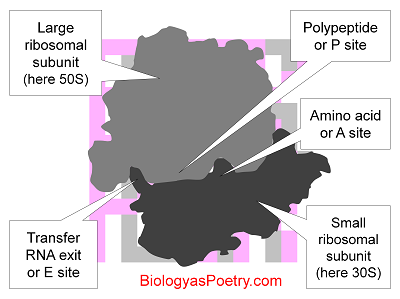∞ generated and posted on 2016.08.26 ∞
Complex RNA- and protein-based organelles responsible for catalyzing the polymerization of amino acids into polypeptides.
Think of ribosomes as machines where the reading nucleotide sequence information associated with mRNA takes place to translate that information into amino acid information.

Figure legend: Bacterial ribosome showing small (30S) and large (50S) subunits. The A site, P site, and E site are ratcheted through by mRNA. The A site where aminoacyl tRNAs associate with the ribosome. The P site is where the same tRNA, now carrying the growing polypeptide chain is located. Finally, the tRNA, having had its polypeptide transferred to the next incoming tRNA, exits from the ribosome at the E site.
Since ribosomes are located in the cytoplasm whereas DNA is located within the nucleus, transcribed RNA must be transported out of the nucleus for translation to take place. So too the proteins found within the nucleus must be imported back in from the cytoplasm. Both of these situations are seen in eukaryotic cells but not bacteria. On the other hand, in all cases ribosomes associated with membranes are responsible for synthesizing proteins that either cross or are inserted into membranes.